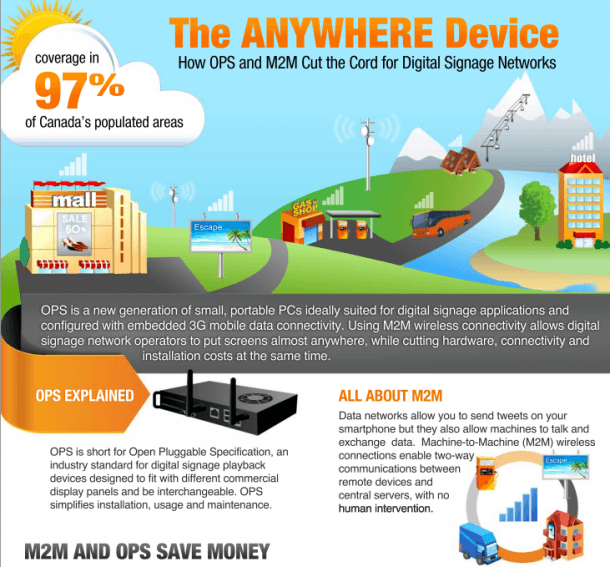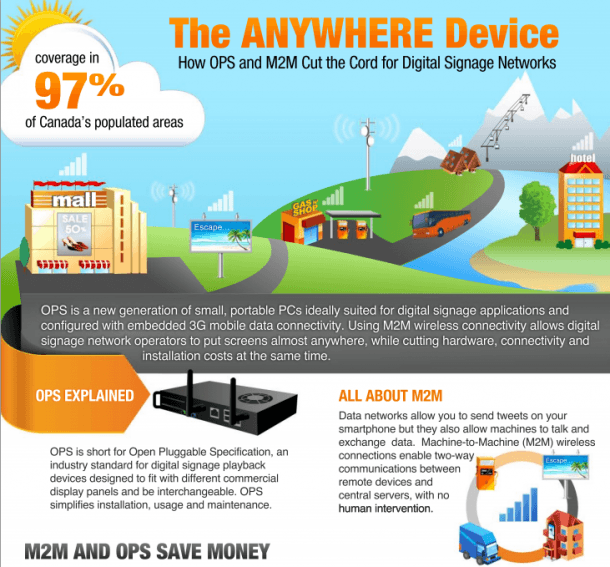
M2M Gets Built Into Digital Signage PCs; Halves Connect Costs
September 18, 2013 by Dave Haynes

Machine-to-Machine wireless communications has been around for several years now and has made some inroads in to the digital signage eco-system, but it’s been hindered by a few things.
USB data sticks that business travellers use to get online while on the road are great for that, but are generally terrible as reliable 24/7 devices. They drop … a lot.
Commercial 3G modems can be bulletproof and first responders use M2M devices in their vehicles, but those devices are big-time expensive.
Finding the right people to talk to in the labyrinth of big phone companies is a test of tenacity and will, at times.
So what if the 3G data modem was built right into a digital signage player, and pre-configured by some major carriers? And the price point was half that of most line connections in business?
That’s the proposition Toronto-based TTUFF Technologies is announcing, through Telus and Sprint.
TTUFF, which has been in the digital signage space selling PCs for many, many years, has announced a program that embeds a 3G modem in two of its OPS media players – the kind that load into slots in certain displays.
Says the release from this morning:
Using 3G M2M networks can cut typical broadband connection fees in half, remove landline installation costs and hassles when digital signage networks are deployed, and make internet data transfers possible in all but the most remote areas of a country.
“From the many years we’ve been supplying rugged PCs to the digital signage market, we know connectivity has always been a big pain point for operators,” says Doug Wismer, VP, Sales and Marketing for TTUFF Technologies. “M2M is the ubiquitous answer to all those deployment sites where bringing in DSL or cable is impossible or very costly. M2M is also infinitely more simple and reliable, not to mention cheaper, than two-way satellite.”
In Canada, TTUFF is working with TELUS Communications, one of the country’s largest telecommunications firms, on a custom offer that incorporates a 3G modem directly in the latest TTUFF OPS units.
“TELUS sees a lot of opportunity for M2M in the digital signage and digital out of home advertising sectors,” says Jim Senko, vice-president, Small Business marketing at TELUS. “The partnership we’ve developed with TTUFF perfectly aligns with operators who’ve told us they want to control costs, increase reliability, and both unify and simplify their connectivity solution. This does all of that.”
Similar arrangements are being finalized for coverage in the US through Sprint and their M2M Solutions group.
The TTUFF OPS series has 3G cellular network data modems embedded in a modular PC chassis, enabling digital signage network deployment teams to easily install the PC with the display. The design eliminates the requirement and cost of data modems, routers and additional wiring.
The OPS standard refers to small, slim and modular PCs that can be readily loaded in openings designed in commercial LCD panels of multiple display manufacturers, including Samsung, NEC and Philips.
TTUFF’s OMIS-OPS-2-3 and OMIS-OPS-2-5 units have Intel Core i3 and i5 Sandy Bridge CPUs, 320 GB HDDs, Windows 7 Pro and embedded TELUS-specified 3G data modems.
The highlights of the M2M/OPS offer include:
- Low cost high-speed data with no long-term contracts;
- Greater than 97% coverage of the Canadian population, via TELUS M2M;
- No activation fees or extra site installation costs;
- Available real-time network monitoring;
- Hibernation billing options for seasonal and intermittent network usage.
“This is immensely appealing to a number of different sectors,” says Wismer. “Getting broadband into retail and food service environments can be very difficult because of the sea of asphalt between the roadway and lines, and the shopping mall. Unless the site is in a very remote area, all that’s really needed to establish the data connection and get a digital sign operating is power.”
A few things catch my eye here. A separate doc in the release package says the monthly tariff is $34 for 1GB, which is genuinely half that of business cable or DSL, and there’s not activation fee or labor needed for pulling lines, etc, etc.
I also like that this is month to month (unlike the normal wireless world of 2 and 3 year commitments). Telus is also offering a sleep mode thing on accounts, which means seasonal businesses like golf courses could keep the account and gear in place but drop from $34 a month to a buck or two through the off-season. A gig is not a huge amount of data, but probably more than enough for a lot of networks, particularly that update information more than video.
The catch here, of course, is you are using a certain PC with certain specs at a certain price point, and if you are not going down that route you have to sort out your own technical solution (and it’s not data sticks … trust me).
TTUFF did a good infographic explaining how this stuff works. Worth a view.



Leave a comment